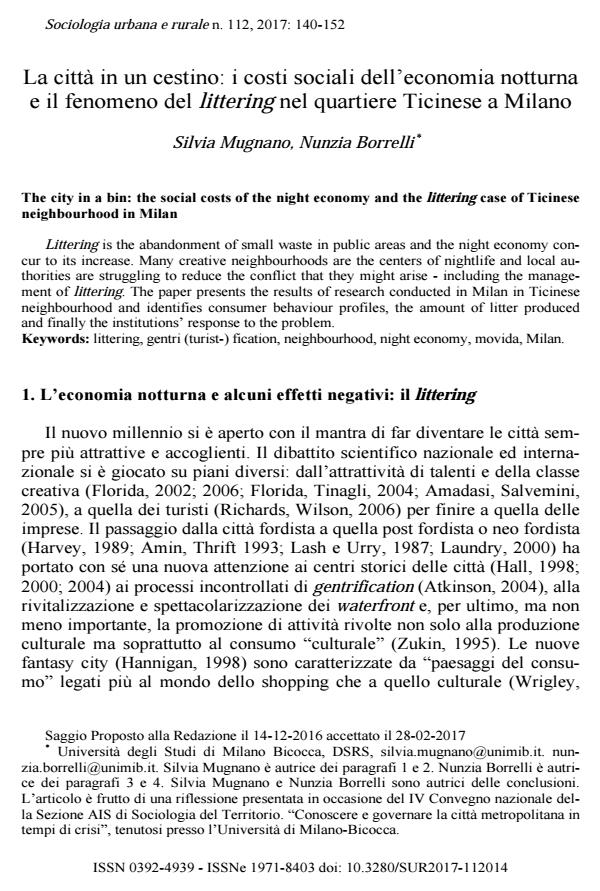La città in un cestino: i costi sociali dell’economia notturna e il fenomeno del littering nel quartiere Ticinese a Milano
Titolo Rivista SOCIOLOGIA URBANA E RURALE
Autori/Curatori Silvia Mugnano, Nunzia Borrelli
Anno di pubblicazione 2017 Fascicolo 2017/112
Lingua Italiano Numero pagine 13 P. 140-152 Dimensione file 213 KB
DOI 10.3280/SUR2017-112014
Il DOI è il codice a barre della proprietà intellettuale: per saperne di più
clicca qui
Qui sotto puoi vedere in anteprima la prima pagina di questo articolo.
Se questo articolo ti interessa, lo puoi acquistare (e scaricare in formato pdf) seguendo le facili indicazioni per acquistare il download credit. Acquista Download Credits per scaricare questo Articolo in formato PDF

FrancoAngeli è membro della Publishers International Linking Association, Inc (PILA)associazione indipendente e non profit per facilitare (attraverso i servizi tecnologici implementati da CrossRef.org) l’accesso degli studiosi ai contenuti digitali nelle pubblicazioni professionali e scientifiche
Littering is the abandonment of small waste in public areas and the night economy concur to its increase. Many creative neighbourhoods are the centers of nightlife and local authorities are struggling to reduce the conflict that they might arise - including the management of littering. The paper presents the results of research conducted in Milan in Ticinese neighbourhood and identifies consumer behaviour profiles, the amount of litter produced and finally the institutions’ response to the problem.
Parole chiave:Littering, gentri (turist-) fication, neighbourhood, night economy, movida, Milan.
- Amadasi G., Salvemini S. (a cura di). (2005). La città creativa. Milano: EGEA.
- Amendola G. (a cura di) (2008). Città, Criminalità, Paure. Napoli: Liguori.
- Amin A., Thrift N. (1994). Living in the global. In Amin A., N. Thrift (ed.) Globalization, Institutions and Regional Development in Europe. Oxford: Oxford University Press.
- Atkinson R. (2004). The evidence on the impact of gentrification: New lessons for the urban renaissance? European Journal of Housing Policy, 4: 107-131. DOI: 10.1080/1461671042000215479
- Avallone G. (2002). The ‘Movida’: The leisure and the work in Salerno night-time. Some notes about a research. The International Journal of Urban Labour and Leisure, 4.
- Burgess R.L., Clark R.N., Hendee J.C. (1971). An experimental analysis of anti-litter procedures. Journal of Applied Behavior Analysis, 4: 71-75.
- Chatterton P., Hollands R. (2003).Urban nightscapes: youth cultures, pleasure spaces and corporate power. Londra: Routledges.
- Chatterton P., Hollands R. (2002). Theorising urban playscapes: producing, regulating and consuming youthful night life city space. Urban Studies, 39: 95-116. DOI: 10.1080/00420980220099096
- Cialdini R., Reno R., Kallgren C. (1990). A focus theory of normative conduct: Recycling the concept of norms to reduce littering in public places. Journal of Personality and Social Psychology, 58: 1015–1026. DOI: 10.1037/0022-3514.58.6.1015
- Clark R.N., Burgess R.L., Hendee J.C. (1972). The development of anti-litter behaviour in a forest campground. Journal of Applied Behavior Analysis, 5: 1-5.
- Decataldo A., Lipari L. (2015). Analisi del fenomeno del littering negli spazi pubblici urbani. Il caso di Milano. Sociologia urbana e rurale, 109: 111-131. DOI: 10.3280/SUR2016-109006
- Farrell T.A., Marion J.L. (2001). Identifying and assessing ecotourism visitor impacts at eight protected areas in Costa Rica and Belize. Environmental Conservation, 28: 215- 225. DOI: 10.1017/S0376892901000224
- Florida R. (2002). The rise of the creative class and how it’s transforming work, leisure, community and everyday life. New York: Basic Books.
- Florida R. (2006). The flight of the creative class. Liberal Education, 92: 22-29.
- Florida R., Tinagli I. (2004). Europe in the Creative Age. London: Demos.
- Geller E.S. (1975). Increasing desired waste disposals with instructions. Man–Environment Systems, 5: 125-128. DOI: 10.1177/0013916595272004
- Geller E.S. (1976). Behavioral approaches to environmental problem solving: littering and recycling. Paper presented at the Association for the Advancement of Behavior Therapy, New York.
- Geller E.S. (1995). Actively caring for the environment: An integration of behaviorism and humanism. Environment and Behavior, 27: 184-195.
- Hall P. (1998). Cities in civilization. London: Weidenfeld and Nicholson.
- Hall P. (2000). Creative cities and economic development. Urban Studies, 37: 639-649. DOI: 10.1080/00420980050003946
- Hall P. (2004). Creativity, culture, knowledge and the city. Built Environment, 30: 256-258.
- Hammigan J. (1998). Fantasy city. London: Routledge
- Harvey, D. (1989). The condition of postmodernity an enquiry into the origins of cultural change. Oxford:B. Blackwell
- Landry C. (2000). The creative city: London: Earthscan.
- Lash S., Urry J. (1994). Economies of signs and space. London: Sage.
- Lovatt A., O’Connor J. (1995). Cities and the Night-time economy. Planning Practice and Research, 2: 127-135. DOI: 10.1080/02697459550036676
- Mazzette A., Bovone L., Rovati G. (2005). Effervescenze urbane: quartieri creativi a Milano, Genova e Sassari. Milano: FrancoAngeli.
- Minardi E. (1999). Economia e Sociologia della notte, Faenza: Homeless Book.
- Pouting D., Robins D. (2000). Cool Rules. Anatomy ofan Attitude. New York: Reaktion Books.
- Richards G., Wilson J. (2006). Developing creativity in tourist experiences: a solution to the serial repro-duction of culture? Tourism Management, 27: 1209-1223.
- Roberts M. (2006). From ‘creative city’ to ‘no-go areas’- The expansion of the night-time economy in British town and city centres. Cities, 23: 331-338.
- Schultz P.W., Sibley C.G., Liu J.H. (2013). Littering in Context: Personal and Environmental Predictors of Littering Behavior. Environment and Behavior, 45: 35-59.
- Wilson J.Q., Kelling G.L. (1982).Broken Windows. The Atlantic Monthly, 249 : 29-38.
- Wrigley N., Lowe M. (1996). Retailing, Consumption and Capital: Towards the New Retails Geography. Harlow: Longman.
- Zukin S. (1995). The cultures of cities. Oxford: Blackwell.
- Tra consumo e rischio: l'ambivalenza della vita di notte tra gli studenti di Montpellier e di Bologna Gabriele Manella, Emanuele Giordano, Tommaso Rimondi, Dominique Crozat, in SOCIOLOGIA URBANA E RURALE 126/2022 pp.97
DOI: 10.3280/SUR2021-126006
Silvia Mugnano, Nunzia Borrelli, La città in un cestino: i costi sociali dell’economia notturna e il fenomeno del littering nel quartiere Ticinese a Milano in "SOCIOLOGIA URBANA E RURALE" 112/2017, pp 140-152, DOI: 10.3280/SUR2017-112014